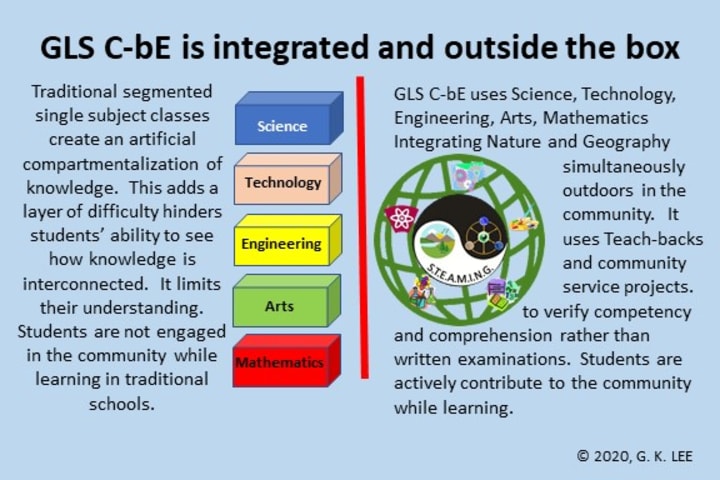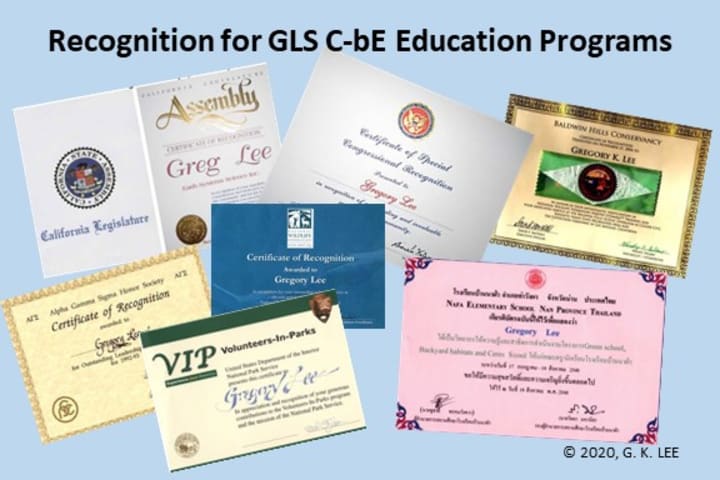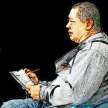
Like many good ideas, community-based education is implemented in many ways. There’s no “right or wrong” way to do it. The implementation depends on the community. This is an introduction to the GLS Community-based Education (C-bE) model. [Note: In the early years, I just called it C-bE. The present name GLS C-bE came into being in Jan 2020. It is used throughout the paper to avoid confusion with other community-based education models.]
The purpose of this paper is to facilitate a discussion for parents, students, teachers, school leaders, trainers in businesses and community leaders. I developed my C-bE model to better serve my students outside the box of the classroom and campus. I needed a way to escape the bureaucracy of the school system and the compartmentalization of subjects. In Nature, all things are connected and interact simultaneously. I wanted to reconnect my students with Nature. I wanted them to use their classroom lessons in the community and world. Because it was not required for class, students had to volunteer to participate. I see self-selection as the first step to success.

These basic assumptions shape the learning environment for GLS C-bE. Babies and children are self-learners. Even before they can speak, they learn without any teachers. They biologically respond to external stimuli and develop neural pathways. It may not sound like learning as most of us think of it. It certainly isn’t done according to a curriculum with standards and tests.
Parents are the first teachers of children. Yet most parents do not have formal training as educators. Most do not have college degrees or teaching credentials. Yet parents prepare children to go to school with basic skills so teachers and caregivers can supervise them. GLS C-bE uses this process to define teachers and students. The long-range goal is to help people learn to become life-long learners and to be their own best teachers. In GLS C-bE, teachers are people who care to share their knowledge, skills, and experience with others. Students learn best when they want to know about a topic.

KEY COMPONENTS
All GLS C-bE lessons and training modules are adapted to a specific project or job. The following components are used to develop Practical Applied Learning activities. By practical, I mean a person proves they understand the lesson by doing the work or task effectively. I don’t use paper tests. Passing a written test about a subject is one thing. Doing the work is another. Collaborative learning in project teams gives students instant feedback. Students help each other learn by working together to get a project done. This also helps develop effective interpersonal communications, resolving differences of opinion, synthesis, and synergy. A team community-service project is closer to the reality of the workplace than a typical classroom lesson.

The Geographic Systems Model (GSM) connects all life, physical, and social sciences to Nature. In Nature, all things are directly or indirectly connected. Once a topic is stated, you place yourself in the GSM. The model suggests linkages to the rest of the natural world. For example, if you are studying soil erosion, you begin in the Lithosphere. You will need to know about the geology and topography of the land which is subjected to erosion. Arrows pointing to the Lithosphere come from the Atmosphere, Biosphere, and Hydrosphere. (See the diagram below.) This suggests you look for materials or energy coming from those parts of the environment. The Atmosphere is the source of weather which directly affects erosion. The amount of rainfall and when it occurs need to be considered. Plants growing in the area play a role in the soil erosion process. So do animals feeding and walking in the area. These are part of the Biosphere. The Hydrosphere comes into the study if you are close to a lake or seashore, or along a river.

Recent changes in curriculum development are shaped by STEM (Science, Technology, Engineering, and Mathematics). Adding the Arts (e.g. language, performing, graphics, etc.) changed STEM to STEAM. I adapted STEAM by Integrating Nature and Geography to produce STEAMING.

GETTING OUT OF THE BOX
We prefer to do learning activities outdoors. We want to work outside the box of the classroom. We want people to connect with Nature. Working on a community service project creates a real-world learning environment. Surrounded by Nature, students see and experience how natural processes are interacting simultaneously. They cannot limit their activity to only a single subject (e.g. math) portion of the project. To measure something, they must deal with all other factors simultaneously in the environment. STEAMING puts the classroom lessons into a real-world context where there are few single “right” answers. This is a direct contrast to a classroom and textbook learning system.

Recent research is showing the health benefits by being outdoors. It doesn’t take a big budget to get children outdoors and connect with Nature. You only need to foster, nurture, stimulate, and protect their curiosity. They are natural learners.

A BIT OF GLS C-bE HISTORY
Here is an overview of the history of GLS C-bE. We started in the Los Angeles urban area with community college students. We adapted it to train rural farmers in northern Thailand. We expanded the community service program for college students by having them teach-back to inner-city high school students. We returned to a different area of northern Thailand to adapt it to rural elementary school students.

Community College Service-Learning
About 1993-2007, GLS C-bE began as the service-learning option for a community college Geography course. Students could make up for missing assignments by participating in a variety of one-day volunteer activities with local community groups. They were given worksheets to document their use of classroom learning to a “real-world” activity outdoors. This was the opportunity to connect abstract lessons with practical skills. They could use these activities to gain practical experience, enhance their resumes or college applications. They made contacts in the community which could lead to letters of recommendation, internships, and jobs.

Adapted to Train Rural Thai Farmers
GLS C-bE can be used by learners of all ages. Early field trials in northern Thailand was a volunteer project I led for the Los Angeles Geographical Society from 1999-2000. It was a grassroots direct people-to-people program. It was completely funded by the volunteers. It used no government funds. [Note: The lessons were created for American community college students, but field tested in rural Thailand. If rural Thai farmers with elementary school education and who cannot speak English, can learn the lessons, college students in the US (including non-native speakers) should be able to do the lessons.]
When training began in 1999, many villagers could not understand why a foreigner (with no relatives in the village) would come to train them. They were told a few volunteers could get free training in composting and soil erosion management. This included basic soil testing and making check dams. The volunteers had to set time aside for the week of training. In exchange, they promised to teach-back to at least 4 other people. The village would provide room and board for the trainers.
The program began with 5 volunteers from 3 villages. All training was hands-on field training using minimal English and Thai translation. It was basically learning by doing. The composting demo involved creating a small 1 cubic meter pile. Soil testing used recycled materials to conduct no cost/low cost, no tech/low tech methods. In contrast commercial soil test kits range in cost from $12-$100. Sending soil samples to a commercial lab can average about $1,200. In terms of the local Thai economy, a $12 test kit would be equal to more the 3-days’ pay in Thai currency. Soil erosion management focused on planting “King’s grass” (Chrysopogon zizanioides) to reduce sheet erosion and making check dams to reduce gully erosion.
This initial field trial was a success. The 5 trained volunteers were excited and eager to train others. Based on this, we announced follow-on training the next summer. Before the second training, the volunteers met to review the past year. The group was discouraged at their perceived slow progress. Skepticism began to grow. Over lunch, one of the trainees inspired the others by saying “If Mr. Lee cares about this place to come two times, maybe we should care, too.”
Three years after the start of the project, the training spread to nearly 600 people in 19 villages. Villagers formed eight teams to make compost commercially. Every 3 months, each team made and sold about 3,000 kg of compost.

College Students Teach-back to Inner-city High School Students
GLS C-bE was used in Los Angeles inner-city neighborhoods. There were three goals: 1) encourage high school students to stay in school and to go on to college; 2) use outdoor backyard gardening for neighborhood beautification, protecting local pollinators, and to use the family backyard for science education and emergency preparedness training through backyard camping; 3) to connect inner city youth with Nature and take them to State and National Parks to introduce them to camping and volunteer work in parks that could lead to outdoor jobs. All training required “buy-in” and a commitment to “teach-back” to four others. As part of Earth Systems Science, Inc., we used GLS C-bE to create the Expo Rangers program for the Expo Neighbors Association.
A bonus came when the students asked for a chance to take their parents and siblings on a weekend camp out. During the weekend, the students took the lead with the adult trainers taking a backseat. The students led their families on a Nature hike. All the adult trainers were English speakers only. Many of the parents were non-native English speakers. The students took turns giving the narrative in English and their native languages. The surprise for many students was how much knowledge their parents had about the different plants. Everyone came away with better insights, respect, and appreciation for each other. The adult trainers stepped back and observed the students being teachers. After the hike, the students and adult trainers held a debriefing and critique. It was a lively and constructive dialog. Adult trainers asked leading questions. The students constructively critique themselves on how to improve, what information could be added next time, etc.

Focusing on Youth
We have a special interest in educating youth. They are the future of the world. Reviewing the use of GLS C-bE in a rural and urban setting drew our attention to the major differences. In Thailand, a major hurdle was the time factor. The farmers were adults with full and busy lives. Their priority was earning enough to support their families. It was hard to arrange times to train the volunteers. Their farm and farm work were top priorities. Using teach-backs was effective, but that took more time than holding a larger training group. But it was hard to arrange larger group gatherings. Training the youth in inner-city LA was easier because they had to be in school at specified times of the day. They were eager to get out of the box of the classroom and “play” outdoors. The GLS C-bE methods (in contrast to the traditional classroom) made learning “fun.”
Due to our limited resources, we decided to focus future training on young students. 1) The youth are the future. 2) They have the freedom to focus on learning (if they saw it as fun). They didn’t have adult worries to inhibit them. 3) in contrast to adults, they didn’t have as many habits entrenched from years of use. 4) Teach-backs would be aimed at people outside of their school. This could be other youth who may not be in school (for whatever reason), family, and neighbors. This would spread the training beyond the school boundaries.

In rural areas, elementary school may be local or in a nearby village. As they get older and move onto high school, they must travel a bit farther from home. If they can go to university, chances are it will be far from home. As the distance from home increases, family ties are stretched, many are stretched near to the breaking point. GLS C-bE is education “of, for, and by the people” with the long-term goal of building a stronger sense of community. GLS C-bE uses classroom lessons applied to local community issues (the environment), sustainability, and disaster resilience. Doing outdoor lessons as community service projects gets students actively contributing to their community. Many younger students are viewed as “children” and dependent on adults. By engaging young students in completing a meaningful community project, they become active members contributing to the well-being of the community. This helps strengthen the bonds between community members.
GLS C-bE Rural Thai Elementary School Pilot Program
We piloted a project in a rural Thai village elementary school from 2004-2007. The teachers and staff were given general descriptions of three age-appropriate programs:
• Green School (basic recycling for K-grade 2) to teach students to properly identify and sort recyclable materials.
• Habitat Garden (grades 3-4) to protect native pollinators using the National Wildlife Federation Schoolyard and Backyard programs as examples.
• NASA CERES S’COOL Observation (grades 5-6) to connect the school science program with an international space technology Earth observation project.
The teachers were given free rein on how they would implement these programs. They were given one year to put these programs into practice. They were also given computer training to use the internet to communicate from Thailand with us. We had Thai students in the US willing to help with email translation as a service-learning project. The school was committed to increasing the use of English. They wanted students to use English daily. If the school did this, we would bring a group of American students to visit the school for a week. Thai students and teachers could interact with native English speakers. The American students would teach-back their lessons to the Thai teachers. The Thai teachers would then teach-back to their students while being observed and debriefed by the American volunteers. Click on the links to see the REEEPP reviews for the first year and second year.

RECOGNIZED SUCCESS
GLS C-bE evolved over 14 years of practical field trials in rural and urban settings, both in the US and overseas. The core elements have remained consistent with minor adjustments. The changes made are in the areas of working with people to adjust the model to suit their needs and situation. We’ve received national, state, and organizational certificates of appreciation and recognition for our educational community service efforts.

MAKING GLS C-bE RESILIENT AND SUSTAINABLE
The following graphics are brief descriptions of the various elements of GLS C-bE. Some of these elements help disperse the training beyond the initial group of learners. Others help keep the system updated and responsive to changes. Together, these elements make the GLS C-bE model sustainable.
The acronyms share an agricultural theme. We created them with the idea many practical lessons would be related to sustainable agricultural practices. The idea was to protect small rural family farms and the livelihoods of local farmers. The lessons help these family farms to become more productive: by using no-till planting methods; protecting all bare soil; protecting and encouraging biodiversity on the farm; avoiding, reducing, and eliminating the use of synthetic chemicals on the farm. [Note: Don’t get distracted by the agricultural and environmental references. The GLS C-bE model is flexible and adaptable. We have applied the model to general education, emergency preparedness, and emergency communications.]
PLANT is the fundamental educational approach in GLS C-bE teaching and training. Students self-select to participate in the learning activity. We assume people will learn what they want to learn. If they cannot connect the learning to themselves (e.g. being personally useful or important), they have little interest to learn it.

REEEPP is the GLS C-bE model to reform rural public education introduced at a small rural village elementary school from 2005-2007. This acronym came from the idea we sow seeds of a different teaching approach, then reap the results.

MULCH is putting Teach-backs into practice. We want people to share their learning beyond the site of the class or training area. PAL is structured to create activities relevant to the learners’ lives. If a lesson is not useful, why would you expect a student to want to study it?

WATER reminds us the world is dynamic and changing. We need to periodically review lessons and activities and adjust them as needed. There are many reasons and conditions causing changes. Ignoring changes reduces the usefulness and effectiveness of the lessons.

SEEDS are how perennial plants persist in the environment. So GLS C-bE creates sustainable educational activities to persist over time. This is the process to revise and update lessons and activities. The process includes literature reviews and any relevant research. Preliminary revisions are subject to beta testing to check for continuity, clarity, and accuracy.

GLS C-bE is education of, by, and for the people. We are willing to share this community-based education model with people around the world who are willing to use education to make the world a better place.
Thanks for reading this article. Please feel free to share it with others. Remember, it is better to network than to not work.






Comments
There are no comments for this story
Be the first to respond and start the conversation.